Why the Jews of Khazaria, the Himyarites and GokTurk Empire Are Keys to Universal History
Why the Jews of Khazaria, the Himyarites and GokTurk Empire Are Keys to Universal History
[Truth Comes to Light editor’s note: Matthew Ehret (along with his equally brilliant wife Cynthia Chung) offer deep research and often unique insight into the history of humanity. I am sharing this here with respect for this excellence. Near the end of the article you will find a disparaging comment about the work of David Icke. This felt out of place to me. Regular readers of this site know that we post the work of David Icke now and then. I respect the work of both without needing to agree with or align completely with the perspective of either man. ~ Kathleen]
Why the Jews of Khazaria, the Himyarites and GokTurk Empire Are Keys to Universal History
by Matthew Ehret, Matt Ehret’s Insights
October 18, 2023
With the fires of potential global war once again erupting across the Middle East, and with obvious anti-jewish rage amplifying to an extreme degree, I would like to take a moment to follow up on a previous essay titled ‘The Peace of Westphalia as a Lesson in Solving Religious Wars Past Present or Future’.
The purpose of this investigation into the deep structure historical dynamics shaping our present world is not to simply romanticize bygone ages but to help clarify the principled dynamics that feudalist oligarchs have been obsessively trying to destroy over the course of the past two millenia. I here refer to the dangerous outbreak of peace through cooperation that has tended to occur between religious rivals in never-ending wars across the ages.
In this location, I would like to go a little deeper into the longer wave of history shaping our presently confused age by taking a look at the Jewish Kingdom of Khazaria (8-11th century CE).
Taking the time to investigate this important part of world history is additionally important as China’s New Silk Road currently represents the greatest hope for peace amongst various faiths and cultures not only in the Middle East, but globally. This is not the first time that the Silk Road ushered in a hope for a new age of reason amongst diverse cultures and as we shall soon see, the Kingdom of Khazaria played a major role in that endeavor which St Augustine called a City of God well over a millennium ago.
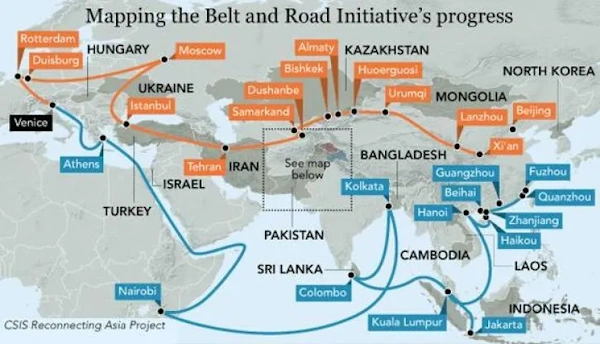
The Mystery of Khazaria in the Modern Era
Typically well informed readers who frequent alternative media either have never heard of the Jewish Khazar Kingdom that dominated central Europe, southern Russia and the Caucuses in the 7-10th century or IF THEY HAVE heard of it, they tend to believe that this Kingdom was the source of everything evil up until modern times. Many mainstream scholars tend to simply deny all evidence that this Jewish kingdom ever even existed.
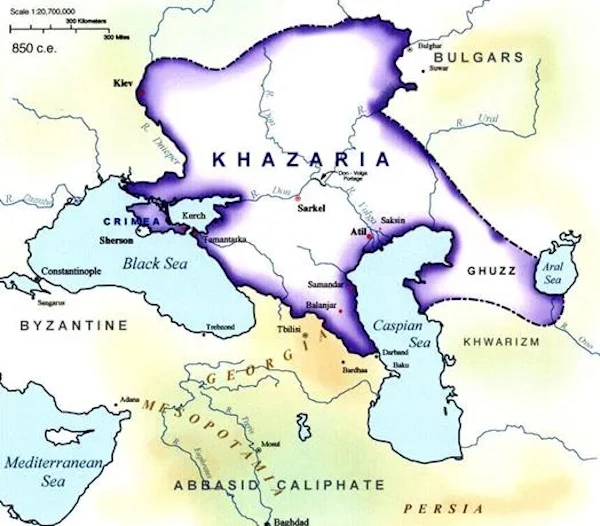
I would like to take a novel approach to this anomalous matter of Khazaria and the broader role of Judaism in world history. Not only do I assert that bountiful evidence allows us to conclude that this Jewish Kingdom certainly did certainly exist, but all existent evidence points to the fact that it was the very opposite to a hotbed for “evil Ashkenazi Jewry” as so many lazy researchers have claimed. Instead, this report will attempt to prove that the forgotten kingdom was not only a beautiful phenomenon uniting all three major Abrahamic faiths under one ecumenical alliance of cooperation for well over a century, but also served as a keystone to the newly reborn Silk Road trade routes uniting Asia with Europe through the Confucian Tang Dynasty (618-912 CE).
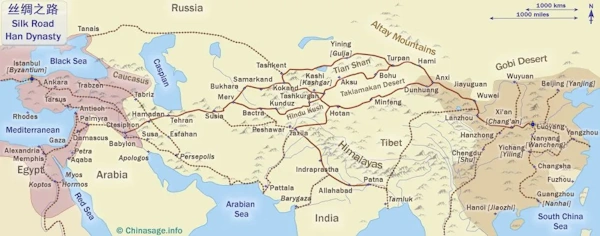
Much of the following report was made possible by the pioneering work of historian Pierre Beaudry in his online book The Charlemagne Ecumenical Principle.
Under a primitive version of Samuel Huntington’s Clash of Civilizations doctrine, the Venetian Empire and the Ultramontane Church which were the heirs of the recently collapsed Roman oligarchy hated the rise of the Carolingian Empire under Charlemagne and the Augustinian humanist educational and economic reforms enacted during Charlemagne’s reign. More importantly, they hated the brilliant alliances Charlemagne oversaw alongside his co-thinker Harun al Rashid (Caliph of the Abassid Dynasty of Baghdad who ruled from 786-809 CE) and the new King Bulan of Khazaria who converted his kingdom to Judaism in the mid-8th century.
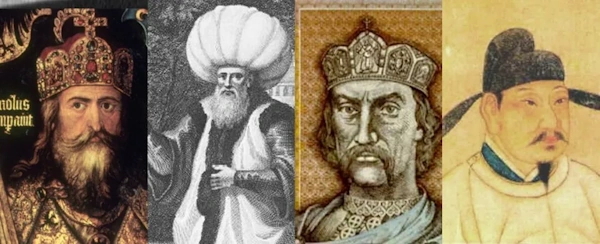
The Turkish Conversion to Judaism: The China Angle
In 578 AD, the vast GokTurk Empire had extended from Mongolia, through Eurasia, all the way to Crimea in today’s Ukraine. The empire that had arisen only 30 years earlier played a major diplomatic role in mediating relations between the Byzantine Empire (the surviving eastern Roman Empire) and the pre-muslim Sassanid Persian Empire.
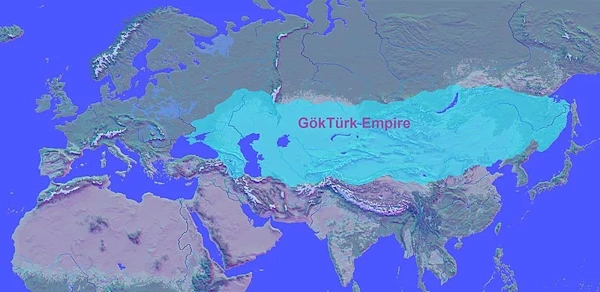
Through a series of marriages with leading princesses of the short-lived western Wei dynasty, and Northern Zhou Dynasty of China (in 562 and 568), leading Khagans of the GokTurks became instrumental in facilitating the revival of the old trade routes of the Silk Road corridors that had fallen into disarray with the collapse of the Han Dynasty in 200 AD.
With the death of the fourth ruler (Taspar Khagan) in 586, warring factions vied for control and a civil war broke out resulting in the eventual split of the Empire into an eastern and western division. Before the emergence of the Tang Dynasty in 618, various rival dynasties in China would also be a factor in the disarray that spread across Central and Eastern Asia during these chaotic years.
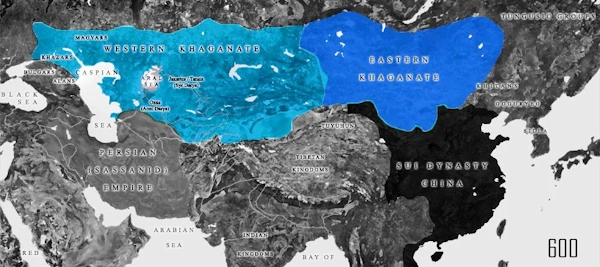
Khazaria was first established in the mid-7th century by the western Turkish Khaganate that had become independent from any obedience to the eastern Turkish parent empire when the later had been defeated militarily by the Taizong Emperor of the Tang Dynasty of China in 643 CE. With the Western Khaganate’s defeat (the eastern branch had been defeated by Li Jing in 630), only the most western branch of the GokTurks remained with Khazaria.
With this 643 victory, the Chinese Emperor was made “Tengri Khagan” (Heavenly King), supreme authority over all Turks. 100,000 Turks then migrated to China’s vastly expanded realm and 10,000 Turkish elites settled in the capital. Letters from various Turkish leaders to the Tang court all the way until 741 CE continued to recognize China’s emperors as “Heavenly Khagan”.
Confucianism spread electrically across the entire Turkic world and the newly independent Turks of the west quickly established a highly developed centralized government in Khazaria whose economy would be based primarily upon fisheries, and agriculture. Khazaria became a keystone in the Silk Road with primary routes of the Steppe Silk Road going east-west over land from Uygur Territory in the east to western Crimea and export/import lines along the Dnieper, Don and Volga Rivers which fed into the Caspian and Black Seas.
Khazaria also held the vital North-South trade route along the Volga from Scandinavia through Central Russia to Islamic Iran and Azerbaijan. Since Venetian steered-wars with Islam made Mediterranean trade impossible, and also made it unsafe for Christians or Muslim merchants to move through each other’s’ territories, this Khazarian route was vital and the role of Jews indispensable for trade.
Anomalies of Jewish Khazars
The fact that Khazaria was founded by Turks with a strong link to China cannot be ignored. When evaluating this fact, we must hold three important facts in mind:
1) Countless scholars have noted the strong Confucian philosophy embedded in the western Turkish Khaganate that established the Kingdom of Khazaria before King Bulan’s later conversion to Judaism sometime around 750CE. Even though they were shamanistic, the Confucian principle of the Mandate of Heaven was a core belief of the Khazarian turks.
2) The presence of Jews in China at this time was anomalously large with the first recorded influx of Jews occurring in 618 CE with the start of the Tang Dynasty. As the Tang emperor revived the Silk Road trade routes that had fallen apart after the fall of the Han Dynasty in the 200 CE, Buddhists, Hindus, Nestorian Christians, Zoroastrians, Muslims and Jews flocked to China. This was an especially positive breath of fresh air for Jews as Professor Pan Guang stated: “they could preserve their native customs and religious beliefs… In education, work, buying and selling of land, marriage and the right to move, they enjoyed the same rights and treatment as Han Chinese. They never faced discrimination”.
This tolerant Chinese policy stood in stark contrast to the persecution and forced conversions had run rampant across the west. Major prosecutors of violence against Jews at the time was driven by Emperors Heraclius (610-641), Justinian II (685-695), Leo III (717-741) and Romanos I (920-944) of the Byzantine Empire.
Much of this persecution stemmed less from religious reasons and more from geopolitical ones as the earlier Jewish Himyaritic Kingdom’s conversion to Judaism in 380 CE disrupted Byzantine interests to control a vital shipping corridor (the Bab el-Mandeb Strait) into the Red Sea off the coast of today’s Yemen. That’s right, between 380 until 525 AD, a major kingdom occupying all of Yemen and major regions of Saudi Arabia was… Jewish. The surviving accounts of Himyarite Dynasty are as scarce as those of Khazaria, but if the accounts of the Christian Priest Symeon of Beth Arsham who lived in the early 6th century are true, then it appears that a Himyarite leader named Yusuf (Joseph) had launched a coup in 524 followed by a persecution of Christians living in and around Yemen. This attack on Christians (if it was true) resulted in a total war of annihilation of Yusuf and the end to the Himyarite kingdom.
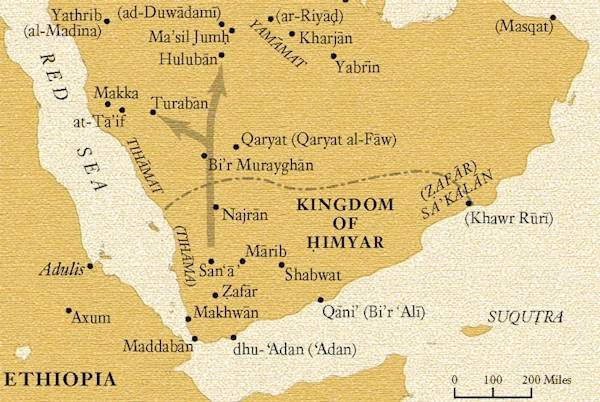
3) The primary group in this early phase of the renewed Silk Road routes were Jewish Radhanite traders originating from the city of Radhan in Iraq. According to Persian scholar al Masudi (896-956), these Jewish traders spoke Arabic, Greek, Persian, Slavic, Spanish and Frankish and according to 9th century geographer Ibn Khurdabhe, there were four Radhanite trade routes linking Europe to China. The primary and most active corridor moving through the Middle East and to Europe was “the Steppe Silk Road” much of which under the jurisdiction of Khazaria.
The Ecumenical Jewish, Christian, Muslim, Confucian Alliance
Al Masudi reported his Meadows of Gold that the Jewish Khazars had established an incredible military alliance with the Islamic Abbasid Dynasty who supplied an army of 10 000 Muslim soldiers to the Jewish Khazars under the condition that if any future Jewish leader were to declare war on Islam, that army would fight for Islam! This incredible safeguard was a creative flank which brought the self-interests of both cultures together in ways that made orchestrated imperial conflict nearly impossible.
Another distinguishing feature of Khazaria was its unique judicial system which wisely represented the diverse faiths which sought refuge in this Jewish land. Khazaria had become renowned for its tolerance and openness (the majority of the population were a mix of Christian, Muslim and Pagan though the King and his court were Jewish). 10th century Persian historian Abu al-Istakhri described the Khazarian Supreme Court of Justice whose judges comprised two Christians, two Muslims, two Jews and one Pagan stating: “The king has 7 judges [hukkan] from the Jews, Christians, Muslims and Idolators. When the people have a lawsuit, it is they who judge it. The parties do not approach the king himself but only these judges.”
The Abbasid Dynasty played another indispensable role in preserving the Silk Road and Confucian renaissance in conjunction with their alliance with Khazaria. At a decisive moment in 755 CE, the Tang Dynasty faced a terrible crisis known as the An-Shi Rebellion when a renegade General An Lushan declared himself emperor of the North threatening both civil war and the dissolution of the new Silk Road. Caliph al-Mahdi (grandfather of the great Harun al Rashid) sent 4000 Muslim soldiers to aid the Emperor in putting down the rebellion, preserving the ecumenical alliance!
It is unfortunate that the Tang Dynasty was never able to recover to its pre-Civil War prestige and the Silk Road lost valuable vitality just as the Christian-Jewish-Muslim alliance was attaining its apex.
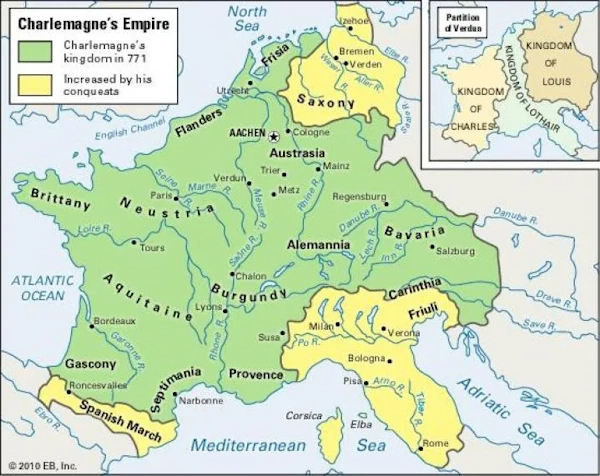
Septimania: European Entry to the Silk Road
We have already noted many surprising and important ecumenical alliances around a higher concept of divine justice and common good in opposition to the policies of the 2nd Roman Empire which operated exclusively on “divide to rule” tactics. However we have left out another important creative alliance worth mentioning.
In 751, the Umayyad Caliphate in Spain lost a major territory called Septimania to the new Carolingian Dynasty of a Frankish King named Pepin the Short (father of Charlemagne) who ruled from 751-768. Septimania, a large area which hosts the strategic port city of Narbonne, had a large Jewish and Muslim population which Pepin and his son allied with against the intrigues of Venice. This area later became a leading renaissance zone reviving the study of Greek classics, astronomy, poetry and medicine under the Andalusian Renaissance centuries later.
Rather than fall into Jewish vs Christian vs Muslim conflicts which the oligarchy would have liked, Pepin instead called for a Jewish leader from Baghdad descended from the House of David named Natronai al Makhir (725-765) to become king of Septimania even giving his daughter Alda to Makhir as wife. Al Makhir in turn gave his Jewish daughter to King Charlemagne in marriage as part of a diplomatic flank against the war mongers in Rome.
Charlemagne ended the anti-Jewish policy dominant in Europe for centuries and even gave Jews rights to land ownership and titles unprecedented in that age. Whenever Charlemagne or his father established diplomatic embassies with the Muslim Abbasids, diplomatic envoys selected were always Jewish. Ultramontane Pope Stephen III who advocated a ‘clash of civilizations’ policy, attacked Charlemagne’s policy in 768 CE writing to the Archbishop Aribert:
“Christians work the vineyards and the fields of these Jews. Christian men and women live under the same roof as these prevaricators, listening to their blasphemous language, night and day; these miserable men and women always have to humiliate themselves before the demeaning display of dogs. What communion hath light with darkness and what concord hath Christ with Balial?”
Both Pepin and Charlemagne ignored the Vatican’s many demands to renounce their ecumenical program.
The governance of Septimania was later divided by Charlemagne with 1/3 under the authority of Archbishop Thomas of Normandy, 1/3 under the Islamic Viscount and 1/3 under Jewish governance ironically putting a Muslim territory under Jewish and Christian protection!
This policy of creative war avoidance and win-win collaboration tied into a Muslim-Christian agreement led by Harun al Rashid in 800 CE when he gave control of the Holy Land to Charlemagne declaring that the Christian leader’s land would be protected by Muslim rule. According to the records of the Monk Zacharias, this diplomatic entente was negotiated by Charlemagne’s Jewish Ambassador to Baghdad Isaac of Rachen.
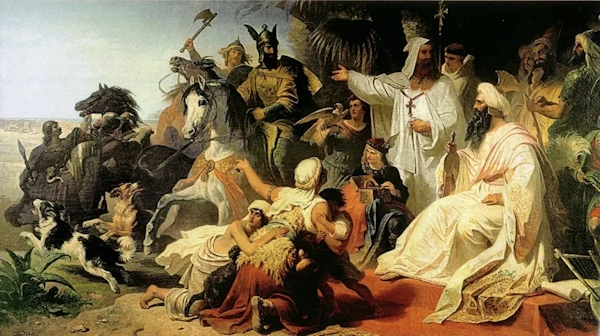
Tying this alliance back to the international geopolitical stage, it is important to recall that Narbonne/Septimania was the key entry point for Silk Road goods to Europe, and its early collapse would have been devastating to the humanist cause. This ecumenical alliance was strong enough to last 90 years before collapsing under the later intrigues of Venice which had managed to get Charlemagne’s small-minded grandchildren to fall into civil war breaking the Carolingian Empire with the 842 Oath of Strasbourg into conflicting regions that later came to become the borders of modern Europe.
The Carolingian Renaissance
Without going into the details of Pepin and Charlemagne’s bold reforms centering on infrastructure (vast roads, bridges over the Rhine, canals, cathedrals and schools), their Irish monastery movement, and financial reforms which saw private financiers lose control as Charlemagne’s government took control of coinage and credit… it is enough for now to state that the Carolingian Renaissance earned its name for the right reasons. The philosophical basis for Charlemagne’s ability to break with anti-Jewish hate was found in the doctrine of Witness formulated by St. Augustine in the early 5th century and which asserted that Jews should no longer be slaughtered, but rather protected since their very existence and adherence to the Old Testament was a living testimony to Christian faith.
Historian Thomas MacDonald said of Augustine’s Doctrine: “His positions is that the Jews are under a divine order of physical protection, and that not only must they be protected, but they must be allowed to worship as Jews… His reason for this view is demeaning for Jews but it also informed centuries of theology and countless orders of protection of Jews living in Christian lands. When Jews were persecuted at the hands of Christians, it was in direct defiance of this doctrine, and when they were protected it was because of this influence.”
The Abbasid Renaissance
In Islam, Augustine’s doctrine found a parallel in the Doctrine of Dimi which asserted that Muslims must protect Jews because they had direct intercourse with the One God whom all Abrahamic faiths share in common.
It is also worth noting that the Abbasid Dynasty was known rightfully as the “Islamic Golden Age” which ushered in a parallel bureaucratic, monetary, and educational reform under the Confucian principle of the Mandate of Heaven (i.e.: A leader’s right to rule was valid only through his obedience to the laws of nature and the common good). This was an anti-oligarchical concept of governance shared by Charlemagne and Caliph al Rashid. Under the humanist leadership of Caliph Al Mahdi, his son Harun Al Rashid and grandson al Mamun, networks of humanist education centers were created called “Houses of Wisdom” which brought Muslim, Christian, and Jewish scholars together to translate ancient works of Greek and Latin, study astronomy, literature, medicine and engineering. Paper mills were established in 832 CE in Samarkand, Cairo, Damas and Baghdad applying Chinese technology to broaden humanity’s access to knowledge.
The Chinese Renaissance
In China, the Tang Dynasty (618-907) distinguished itself early on as an ecumenical safe haven for all cultures and saw influxes of Muslims, Jews and large groups of Nestorian Christians who all made China their home. During the 300 years of Tang Rule, the arts rose to new heights, and the Poet-statesman became an actualized ideal as the greatest poets and painters (such as Wang Wei, Li Bai and Du Fu) played major roles as political figures. Torture and death penalties were nearly done away with and public schools were built at record numbers. Unfortunately, wars with Muslims, Turks, and Tibetans did occur over the years and many internal struggles occurred from within weakening the Dynasty.
Physical evidence of the Khazar Kingdom were nearly all destroyed or suppressed leaving very little empirical evidence to work with for modern scholars (and leaving much room for speculative gossip led by such British Imperial assets like Arthur Koestler or lizard-man quackidoodle David Icke). Luckily, dozens of Christian and Muslim scholars of the 8-12 centuries have written extensively of its existence, and some of the 250 000 fragments discovered at the end of the 19th century in the Cairo Geniza are finally being made public- bringing direct evidence to light for the first time in millennia.
One question is still unanswered: Why did the Khazar Kingdom end by the 10th century and why were all traces of this golden age among Confucianism, Judaism, Christianity and Islam destroyed?
The Venetian Takeover and the Rise of ‘Jewish Bankers’
Here we must look to towards that ugly center of spiritual pus: The heirs of the Roman Oligarchy found in the Lagoons of Venice and Byzantine Empire (soon to be undone by the wilier Venetians in 1251 as outlined in my recent report The League of Cambrai and the BRICS Today and 2009 film The New Dark Age).
Although it took a couple hundred years of effort, the oligarchy was finally successful in breaking up Charlemagne’s unified kingdom into warring factions, and the Islamic Empire soon fell into its own internal and external discord. Finally in 1095, Venice and the Ultramontane Papacy were successful in launching the first Crusade against Islam turning the world upside down. It is noteworthy that all trade routes established by Rhadanite Jews were the first things destroyed in Europe by the Crusaders (organized by the new Templar Cultists) who then took over those routes, using this infrastructure to wage a most unholy war.
The Templar cultists of Baphomet worshippers were themselves created by the grand strategist Bernard de Clairvaux (an enemy of the great Augustinian Platonist Peter Abelard), of the Cistercian order and who put at least two popes into power during his hyper-active lifetime. It was Clairvaux who established the constitution of this gnostic “Christian mercenary” cult that would soon control the majority of banking operations and new era of Christian vs Muslim (and vs Jew) religious violence that would shape so much of the coming centuries. The Templar fixation with Solomon’s temple (their headquarters would be located under the site which was presumed to be location of Solomon’s Temple) and the obsession with the Grail myth (which turned into the British Israelite Cult that presumed the Royal Family to be the progeny of Jesus’ supposed marriage with Mary Magdalene) and also the source of Rosicrucianism, modern masonry and political zionism, presents an important elemental cause to our current global crisis.
Whatever happened to cause the weakening and ultimate collapse of Khazaria under Kiev Rus invasions in 969 is not clear. What is clear is that anti-Jewish laws were imposed at unprecedented rates from the 11th-16th centuries of Venetian global dominance. In the late 10th century, Jews were cut off from Khazaria as all east-west trade routes were taken over by Genoa and Venice. Though other nations soon followed suite, Venice was the first to ban Jews from all international trade with the Venetian Senate passing a law in 945 CE forbidding any ship to Asia from carrying a Jew. Laws were soon passed across Europe on Venice’s direction forbidding Jews from owning land, joining trade guilds of weavers, dyers, carpenters or blacksmiths or owning any trade companies. Other laws like the 1181 English Assize Laws forbade Jews from owning weapons, serving in military or even farming.
The word “Ghetto” began in Venice as well, as Jews were here relegated to a small neighborhood called the Ghetto and were excluded from any normal form of profession being forced to either deal in old rags, pawn broking or money lending for (nominally) Christian oligarchical families who used them as HofJuden servants.
Historian Cecil Roth addressed this devastating situation saying: “The situation would have been an impossible one but for the presence of the Jew, who, precisely as he found himself excluded from other methods of gaining a livelihood, was forced into this most unhonoured profession. The non-Jewish capitalists lent to kings and magnates, under the cover of various devices (such as making out the bond for a larger amount than the sum lent, or euphemistically calling the interest by some other name). The more open, least lucrative, and most unpopular branches of the profession, such as lending on pledge for a short period to the artisan and tradesman, were forced upon the Jews. ”
“In Venice, for example, down to the close of the eighteenth century, the Jewish community was only tolerated on the express condition that it maintains in the Ghetto four loan-banks (a more polite term for pawn broking establishments)… The only other professions legally permitted there were old clothes dealing and the wholesale export trade to the Levant, which did not compete with Christian traders. The same was the case in the cities of the terra firma. This ignominious condition of affairs was sternly enforced, and any attempt on the part of the Jews to broaden their economic status, or to place it on a slightly more dignified plane, was the systematically blocked.”
This now opens the door to our next instalment which will introduce a new perspective to Shakespeare’s Merchant of Venice, and an earlier play known as “The Jew of Malta”.
The author delivered a lecture on this topic which can be accessed here:
Connect with Matthew Ehret website | substack | telegram
Cover image “Turkic warrior from the Gokturk period” credit: Zaziiko